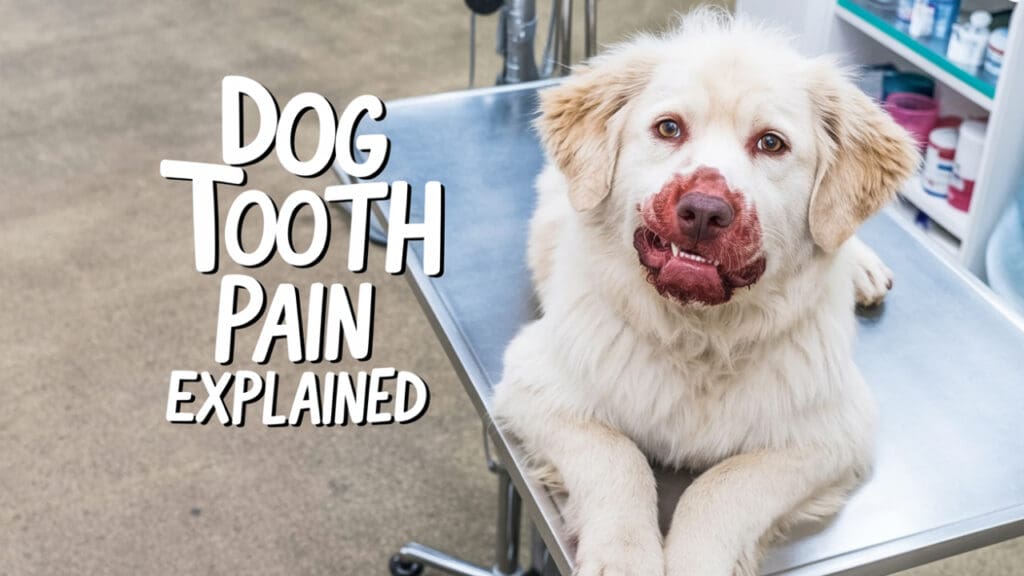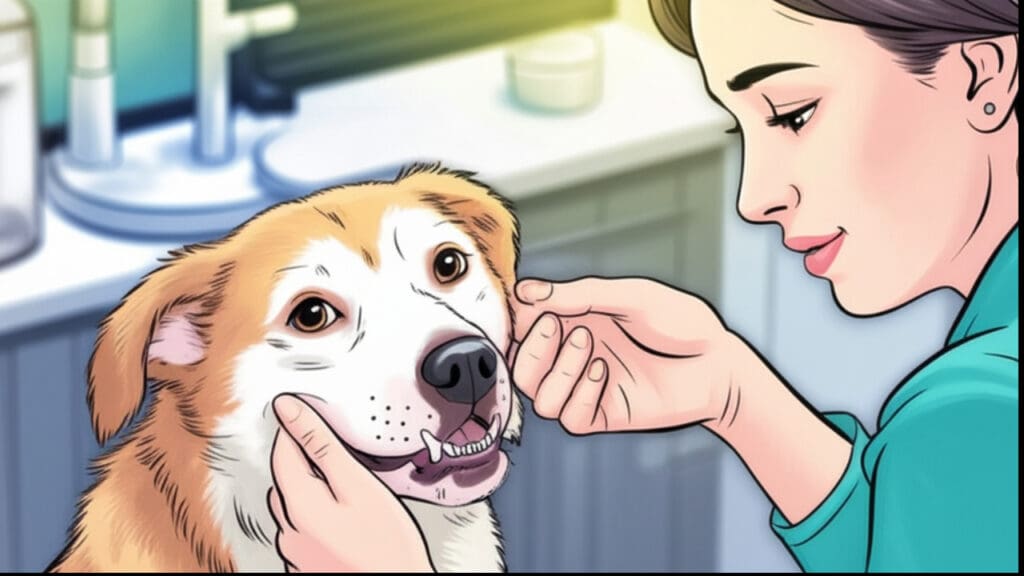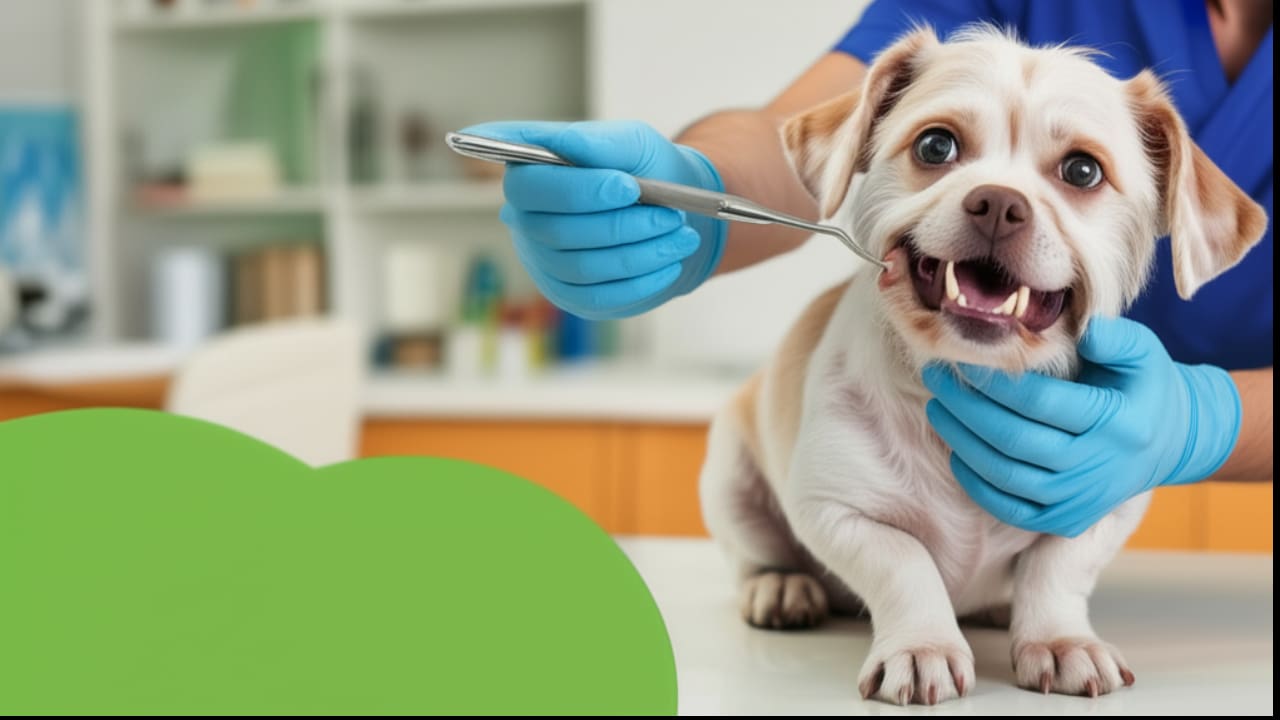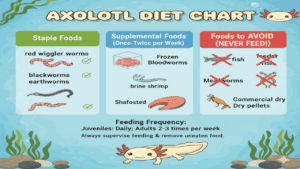What to Give a Dog for Tooth Pain (2025): Vet-Approved Relief, Natural Remedies, Costs, and Mistakes to Avoid
Your dog suddenly stops eating hard food. They start drooling excessively, and paw at their mouth. Your parental instinct kicks in, and you know something’s wrong. Yet you don’t know how to help. Frustrating!
Tooth pain in dogs can be both distressing and dangerous. And knowing what to give a dog for tooth pain could spare them hours (or even days) of suffering.
The safest solutions aren’t found in your medicine cabinet. Most veterinarians recommend prescription-only NSAIDs. Common choices are: carprofen, meloxicam, and deracoxib.
Popular human painkillers such as ibuprofen or acetaminophen can be fatally toxic to dogs. Still, many pet owners unknowingly make this mistake, leading to emergency vet bills that often exceed $2,000.
You want a few gentler options? Expert-approved home remedies like chilled soft food or coconut oil can temporarily soothe discomfort. But they won’t fix infections or root decay.
Keep reading. You’ll discover why untreated dental disease affects over 80% of dogs by age three, how senior pets face unique risks, and the real cost difference between preventive brushing and full dental surgery.
If you want to make informed, compassionate choices for your dog’s health, you’re in the right place, especially if you’re wondering what to give a dog for tooth pain without risking a costly mistake.
Dog Dental Health Quiz
Test your knowledge about tooth pain in dogs and learn how to protect your furry friend from dental emergencies
Why Dental Health Matters for Your Dog
Tooth pain in dogs isn't just uncomfortable - it can signal serious dental problems that affect your dog's overall health and quality of life. Unlike humans, dogs can't tell us when something hurts, making it crucial for owners to recognize subtle signs of dental distress.
This interactive quiz will help you identify symptoms of dental problems, learn safe pain relief options, understand dangerous mistakes to avoid, and know when to seek veterinary care. By the end, you'll be better equipped to protect your dog's dental health and prevent costly emergencies.
Great Start!
You scored 0 out of 10 questions correctly
You have basic knowledge about dog dental health, but there's more to learn to fully protect your furry friend.
Protect Your Dog's Dental Health
Daily Brushing
Brush your dog's teeth 3-5 times per week with canine-safe toothpaste to prevent plaque buildup
Regular Checkups
Professional dental cleanings every 6-12 months can catch problems before they become emergencies
Safe Pain Relief
Only use veterinarian-prescribed NSAIDs - human medications can be fatal to dogs
Understanding Tooth Pain and Dental Problems in Dogs

Tooth pain in dogs isn’t just uncomfortable. It can signal serious dental problems that, if left untreated, may affect your dog’s overall health and quality of life.
But unlike humans, dogs can’t tell us when something hurts. This means we owners must learn to recognize subtle signs and understand the underlying causes of dental distress.
Now, many dog owners assume their pet’s dental health is fine as long as they’re eating, never stopping to ask what to give a dog for tooth pain until it becomes a full-blown emergency.
In reality, dogs will often continue to eat despite pain, especially if they’re hungry or food-driven.
Veterinarians say that the most overlooked signs of dental problems in dogs include bad breath, excessive drooling, bleeding gums, chewing on one side of the mouth, or pawing at the jaw.
Behavioral changes, such as irritability or a sudden reluctance to play with chew toys, can also point to mouth pain.
What causes these issues? Most dental pain stems from conditions like periodontal disease, fractured teeth, oral abscesses, or retained baby teeth, especially in small breeds.
Over 80% of dogs over the age of three show signs of dental disease, making this one of the most common yet under-treated health issues in canine care.
If left unchecked, dental problems in dogs can escalate into infections that spread to the liver, heart, or kidneys.
The cost? While routine dental cleanings may cost $300–$700, treating an advanced tooth infection or performing an extraction could exceed $1,000-sometimes much more, especially for older dogs with other medical conditions.
Vets recommend that owners prioritize regular dental exams and learn their dog’s pain signals. In other words, we shouldn’t wait for obvious symptoms. And early detection can save your dog from unnecessary pain and your wallet from large emergency bills.
Understanding tooth pain in dogs is the first step in protecting their health, because behind every wagging tail could be a silent struggle.
Keep reading! What you learn next could make a world of difference.
What Causes Tooth Pain in Dogs?

Tooth pain in dogs might seem like a minor issue. But it’s often a symptom of deeper dental or health concerns.
Unlike a quick scrape or sore paw, oral pain usually develops gradually, making it easy to miss until the damage is already done. So, what’s actually going on behind your dog’s gums?
The most common culprit is periodontal disease, an inflammatory condition caused by plaque and tartar buildup.
This sneaky disease affects up to 80% of dogs by the age of three and can lead to gum recession, exposed roots, and even bone loss in the jaw.
Add in poor oral hygiene and certain breed predispositions (like pugs and dachshunds), and you’ve got a recipe for chronic pain. Ouch!
Other causes include broken or fractured teeth, often from chewing hard toys or bones, and retained baby teeth-a frequent issue in toy breeds.
Infections such as oral abscesses, gingivitis, and tooth root infections can create severe discomfort and lead to swelling, bad breath, or difficulty eating.
Having said that, know that your dogs rarely cry out in pain, even with advanced disease. That means you need to be proactive (not reactive) about identifying problems.
Veterinary dentists say that a common mistake pet owners make is assuming bad breath is “normal” for dogs. In reality, it’s one of the first red flags of tooth decay or dog teeth disease.
Ignoring it could mean bigger vet bills down the road. Treating advanced dental problems in dogs can cost anywhere from $800 to $2,500 or more, especially if surgical intervention is needed.
What does this mean for you? Pay attention to your dog’s chewing habits, facial expressions, and any sudden behavioral changes. These small clues often point to larger, invisible pain sources.
The sooner you catch the problem, the better your chances of preventing irreversible damage, and protecting your dog’s long-term health.
How Do I Relieve My Dog’s Tooth Pain?

When your dog is in pain, your first instinct is to help. But tooth pain requires more than just comfort and a pat on the head.
It’s not always obvious how to relieve your dog’s toothache without risking harm. So how can you safely ease your dog’s dental discomfort while addressing the root cause?
When figuring out what to give a dog for tooth pain, the safest and most effective path begins with a veterinary dental assessment.
Veterinarians can identify whether your dog’s pain stems from an abscess, cracked tooth, or canine dental problems like advanced gum disease.
Based on their diagnosis, they may prescribe pain-relieving medications such as carprofen or meloxicam, which are anti-inflammatory drugs approved specifically for dogs. These treatments usually cost between $50 and $150, but the relief they offer can be immediate and humane.
Please take this seriously. Giving human medications like ibuprofen or acetaminophen is an absolute no. These drugs are toxic to dogs (even in small doses) and can cause liver failure or gastrointestinal bleeding.
If you’re tempted to reach for something in your medicine cabinet, stop. Only a vet can determine what to give a dog for tooth pain safely.
Now let’s talk about temporary, vet-approved home comfort options. Cooling soft foods (like chilled canned dog food), gentle mouth rinses made for pets, and even frozen carrot sticks (for supervised chewing) may offer mild relief until your vet visit.
But these are not cures. They’re just short-term band-aids. Owners often think the problem is solved if the dog eats again, but eating through pain isn’t the same as healing.
So, if your dog is showing signs of discomfort, don’t wait for it to get worse. Early intervention isn’t just more affordable. It’s also more effective in preserving your dog’s health and happiness.
Safe Pain Relief Options for Dogs With Tooth Pain
If your dog is suffering from dental pain, finding a fast yet safe pain relief option becomes a top priority. But don’t be fooled! What works for humans isn’t always safe for pets.
If you’re googling what to give a dog for tooth pain and eyeing your own medicine shelf, put the Advil down and call your vet first.
Let’s start with the basics. Only use medications specifically prescribed or approved by a veterinarian.
Common veterinary options for managing tooth pain include nonsteroidal anti-inflammatory drugs (NSAIDs) such as carprofen (Rimadyl), meloxicam (Metacam), or deracoxib (Deramaxx).
These are designed for canine use and can effectively reduce both pain and inflammation. Prices typically range from $30 to $80 depending on the dosage and your location, but they provide controlled, professional-grade relief.
Many well-meaning dog owners reach for human medications like aspirin or ibuprofen. This is a dangerous mistake. Even a small amount of acetaminophen or ibuprofen can lead to liver damage, stomach ulcers, or even death in dogs.
Experts warn that if something’s not labeled for dogs, don’t use it. Self-medicating your pet is one of the most common (and costly) errors we see in emergency clinics.
What about holistic options? While they can’t replace medical treatment, chamomile, CBD oil formulated for pets, and cooling gel pads made for canine use may help soothe minor discomfort.
But… always vet these options with your provider first, as not all “natural” products are safe for every dog.
Still with us? Good! Because here’s the part most people miss. Even with the best pain relief, you must treat the cause, not just the symptom.
Painkillers mask the issue temporarily, but without a dental cleaning or treatment, your dog’s condition will likely return (or worsen).
Knowing how to manage pain safely is step one. Solving the problem permanently is what comes next.
Unsafe Treatments to Avoid When Managing Dog Toothaches
When your dog is hurting, it’s natural to want to help. But sometimes our instincts can lead to dangerous mistakes.
Many over-the-counter remedies or home treatments that work for people are completely unsafe for dogs, especially when it comes to managing dental pain.
If you’re wondering what to give a dog for tooth pain, know this. The most common (and potentially fatal) error is giving dogs human medications like ibuprofen (Advil), acetaminophen (Tylenol), or naproxen (Aleve).
These drugs are not metabolized the same way in dogs and can quickly cause stomach ulcers, liver toxicity, kidney failure, or internal bleeding.
Even a single human-sized dose can be enough to trigger an emergency. Vets mention that they see many cases where a well-intentioned owner causes life-threatening harm. In short, human painkillers should never be given without veterinary supervision.
Another risky choice? Using essential oils, topical gels, or clove oil on your dog’s gums. While these are sometimes used in human dental care, they can be toxic if ingested or cause severe irritation in dogs.
Additionally, aspirin, often misunderstood as a “safe” fallback, can interact poorly with other medications and worsen bleeding, especially if dental surgery is needed later.
Let’s break it down. Treating dog toothaches the wrong way doesn’t just risk your pet’s health. It can cost you.
Emergency care for NSAID toxicity or gastrointestinal damage can run upwards of $1,200 to $3,000, depending on the severity of the reaction and follow-up treatments required.
What does this mean for you? Stick to veterinarian-recommended products only, and avoid improvising with human solutions.
While it might feel like you’re doing the right thing at the moment, the consequences of unsafe treatments can be devastating (and expensive).
Instead, focus on safe interventions backed by science, not speculation. Your dog’s health depends on it.
Natural and At-Home Remedies for Soothing Mild Tooth Discomfort
When your dog shows early signs of tooth pain, like hesitating before chewing or pawing at the mouth, you may wonder if there’s anything you can do at home to provide relief.
The good news is… there are a few natural remedies for dog toothache that may help reduce discomfort until you can get professional care.
One of the simplest and safest methods is to offer soft, chilled food. Cold temperatures can help numb minor inflammation, while soft textures prevent further irritation of sore gums or sensitive teeth.
Try refrigerating canned dog food or offering a frozen carrot as a soothing chew. But do make sure you supervise your dog to prevent choking.
Some owners turn to chamomile tea (cooled) for its gentle anti-inflammatory properties. Dabbing a small amount onto a soft cloth and applying it to your dog’s gums may offer short-term relief.
Coconut oil, known for its antimicrobial benefits, can also be massaged gently along the gumline. That is, of course, if you only use tiny amounts, and never as a substitute for dental cleaning.
That said, while these methods may ease symptoms, they don’t cure the problem. That’s a common mistake-using home remedies to mask deeper issues like tooth root infections or gingivitis.
Experts mention that natural solutions work best as supportive care, not as treatment for advanced dental problems.
If you’re looking into budget-friendly ideas and wondering what to give a dog for tooth pain without rushing to the vet, these DIY solutions are appealing.
Most of these items, like carrots, chamomile, or coconut oil, cost just a few dollars. But, relying on them too long could backfire. Delaying proper care may lead to worsening pain and vet bills that climb into the thousands.
So what’s the best next step? Use these gentle remedies for temporary relief.
But remember to always follow up with your vet to address the root cause of your dog’s discomfort. Mild symptoms today could mean serious dental problems tomorrow.
Special Considerations for Old Dog Teeth Problems
You’ve probably noticed. As dogs age, their risk for dental issues doesn’t just increase. It accelerates.
For senior pets, what might start as mild gum irritation can quickly develop into serious old dog teeth problems that impact overall health, mobility, and even lifespan.
So, how do you properly care for an aging dog with dental discomfort?
Older dogs often suffer from advanced periodontal disease, tooth root infections, and worn enamel. These conditions not only cause pain but can interfere with eating, lead to weight loss, or trigger secondary infections in the kidneys, liver, and heart.
Here’s the tricky part. Many signs go unnoticed because seniors are often less active and already slowing down, making subtle shifts in behavior harder to detect.
Unfortunately, experts say that dental health tends to fall off the radar with older pets. But these dogs often need oral exams the most.
This oversight can lead to expensive and risky procedures later. Dental cleanings for senior dogs often require bloodwork, X-rays, and anesthesia precautions, raising the average cost from $500 to over $1,200 per procedure.
So what can you do? Choose softer foods to reduce pressure on sensitive teeth, and consider daily dental wipes or gels designed for aging mouths.
Supplements like coenzyme Q10 or omega-3s may also help reduce inflammation. Just don’t skip veterinary guidance, especially when tooth loss, foul breath, or visible decay is present.
And here’s what most people don’t realize. Pain from untreated dental issues can quietly erode a senior dog’s quality of life.
By prioritizing routine dental checks and adapting home care to suit your pet’s age, you’re not just relieving discomfort, you’re preserving dignity in their golden years.
Keep reading to learn how preventive care can change everything.
The Silent Sufferer: Understanding Canine Dental Pain Levels
Dogs often hide signs of dental pain, which makes it hard to know when they’re hurting. To help with this, veterinary researchers created the Composite Oral Pain Scale for Dogs and Cats (COPS-C/F). This tool helps vets and pet owners spot signs of pain related to oral (mouth) disease.
Common Signs of Dental Pain
The COPS-C/F highlights specific behaviors that may show your dog is in pain:
Feeding Behavior Changes
- Prefers soft food over dry kibble
- Eats differently than usual
- Chews only on one side of the mouth
Physical Signs
- Drooling more than normal
- Pulling away when you touch their face
- Pawing at their mouth or jaw
- Swollen or red gums
Behavioral Changes
- Less interest in people or other pets
- Not grooming as often
- Less active or slow to move
- Doesn’t want to play with toys
What the Experts Say
Dr. Giorgia della Rocca and her team, who developed the COPS-C/F, say that oral pain in pets often goes unnoticed and untreated. Their studies showed that both pet owners and vets need to work together to fully understand a pet’s pain, since each can observe different clues.
Why X-Rays Matter
Groundbreaking research by Verstraete and colleagues found that dental X-rays reveal hidden problems in about 1 in 3 dogs that seem fine, and in half of the dogs with visible dental issues. This means even if your dog looks okay, they could still be in pain-so a full dental check, including X-rays, is important.
How to Prevent Dental Problems with Dogs Through Daily Care
Preventing dental problems with dogs doesn’t have to be complicated. But… It does require consistency.
Most owners don’t realize just how quickly plaque can turn into tartar, and how tartar can pave the way for gum disease, infections, and painful tooth loss.
The good news, however, is that with the right daily habits, you can drastically reduce the risk.
The cornerstone of prevention is daily brushing with canine-safe toothpaste. Many owners skip this step, assuming dental chews or dry kibble are enough.
But that’s not the case. Even the best chew can’t reach under the gumline where bacteria thrive. Brushing just 3–5 times per week can reduce plaque buildup and help avoid costly dental procedures down the line.
Think of it as a $10 toothbrush investment that saves you from a $1,000 vet bill.
Now let’s talk about tools. Dental wipes, enzymatic oral sprays, and water additives can all complement brushing, especially for dogs that resist toothbrushes.
Chews and toys designed to support dental hygiene are great. But they should be used to supplement, not replace, hands-on care. Daily attention to oral health makes all the difference. It’s usually the small things that keep dogs out of the dental surgery suite.
In any case, skipping dental care isn’t just about bad breath. It can shorten your dog’s lifespan.
Chronic oral infections have been linked to heart, liver, and kidney complications. And yet, it’s one of the most preventable health issues in pet care.
What does this mean for you? Prevention isn’t glamorous, but it’s powerful. A few extra minutes each day can protect your dog from pain, prevent avoidable dental problems, and keep tails wagging for years to come.
Ready to take action? The next section will show you what to watch for when it’s time to call the vet.
Your Dog’s Lifetime Dental Roadmap
Good dental care for dogs changes with age. This step-by-step guide follows expert recommendations from the 2019 AAHA Dental Care Guidelines to help keep your dog’s mouth healthy at every life stage.
Puppy Stage (2–6 Months)
Laying the Foundation:
- Gently touch your puppy’s mouth and teeth (start around 8–12 weeks)
- Let your puppy play with soft-bristled brushes like toys
- Use pet-safe toothpaste with your finger to introduce brushing
- Offer soft teething toys (like frozen Kongs or rope toys)
- First vet visit: Check for baby teeth that didn’t fall out and ensure teeth are developing properly
Young Adult (6 Months–2 Years)
Building Healthy Habits:
- Brush your dog’s teeth daily using Petsmile Professional (the only toothpaste approved by VOHC for dogs)
- Start using approved dental chews (like Greenies or OraVet)
- Get a professional dental exam at age 1 for small/medium dogs and age 2 for large dogs
- Important stat: By age 3, up to 89% of dogs already have dental disease
Adult Dogs (2–7 Years)
Routine Maintenance:
- Keep up daily brushing using trusted products
- Get a professional dental cleaning once a year (every 6 months for small dogs under 25 lbs)
- Give dental chews 3–4 times per week
- Watch for early signs of dental problems during regular petting or feeding
- Dental X-rays: Get them once a year or when something looks wrong
Senior Dogs (7+ Years)
Extra Care & Monitoring:
- Visit the vet for a dental checkup every 6 months
- Professional cleanings every 6–12 months depending on your dog’s health
- X-rays every 6 months to catch hidden problems early
- Switch to softer food if your dog has lost teeth or has mouth pain
- Cancer Check: Watch for oral tumors, which are more common with age
Emergency Warning Signs (All Ages)
Call Your Vet If You Notice:
- Swelling or one side of the face looks different
- Bleeding from the mouth or gums
- Trouble eating or chewing
- Broken, loose, or discolored teeth
- Constant pawing at the mouth
- Really bad breath (this is never normal!)
Summary: Key Milestones by Age
| Age | What to Do |
| 8–12 weeks | Start getting your puppy used to having their mouth handled |
| 6 months | Begin regular tooth brushing routine |
| 1–2 years | First professional dental exam (depends on breed size) |
| 2–3 years | Start yearly cleanings with your vet |
| 7+ years | Increase to cleanings and checkups every 6 months |
This plan is based on the latest research and expert guidelines to keep your dog’s teeth and gums healthy for life.
When to Call the Vet: Signs of Serious Dental Conditions
Not every whimper or skipped meal means an emergency. But certain dental symptoms in dogs should never be ignored.
Serious dog teeth disease can escalate quickly, and waiting too long to call the vet could put your dog’s health at risk. The key is knowing what red flags demand immediate professional attention.
One of the most alarming signs is facial swelling, especially near the jawline or under the eyes. This often points to a tooth root abscess, an infection that can spread to surrounding tissue or bone.
Other urgent symptoms include loose or missing teeth, bleeding gums, pus near the gumline, and difficulty eating or chewing.
If your dog suddenly refuses to eat hard food, chews only on one side, or drops food mid-meal, there’s a high chance they’re in pain.
Next, foul-smelling breath isn’t just unpleasant. It’s one of the earliest signs of periodontal disease.
Many owners shrug it off as normal, but persistent bad breath combined with visible tartar or red gums signals infection.
If left untreated, these infections can damage organs, and the cost to treat severe cases may soar to $1,500–$3,000, especially if multiple extractions or hospitalization are needed.
You really shouldn’t assume that occasional discomfort will “clear up on its own.” Dental infections don’t resolve without veterinary intervention.
Experts mention that oral infections in dogs can be as serious as any internal infection. Delay in treatment usually leads to increased risk and cost.
So when should you call the vet? If your dog shows any combination of pain, swelling, bleeding, drooling, or behavior changes, it’s time.
Swift action can prevent worsening damage. And it can bring your dog relief before the pain becomes unbearable. Don’t wait until it’s an emergency.
If you’re unsure what to give a dog for tooth pain, that uncertainty alone is your sign to call the vet.
FAQs About Dog Tooth Pain and Relief Options
When your dog is in visible discomfort, it’s natural to have a flood of questions, especially when searching for fast, safe, and effective solutions.
Whether you’re worried about medications, symptoms, or home treatments, these commonly asked questions provide clear, expert-backed answers to help you make the best decisions for your dog’s dental health.
1. What can I give my dog for immediate pain relief?
Veterinarian-prescribed NSAIDs like carprofen or meloxicam are the safest options. Never administer human medication without veterinary approval.
2. What human medicine can I give my dog for toothache?
You should not give your dog any human painkillers unless explicitly prescribed by a vet. Medications like ibuprofen or acetaminophen are toxic to dogs.
3. How can I treat my dog’s tooth infection at home?
While you can provide temporary relief with soft foods or a cold compress, tooth infections require antibiotics and vet care to fully resolve.
4. Can a dog’s tooth heal on its own?
No, dental injuries or infections won’t heal without treatment. Delaying professional care can worsen your dog’s condition.
5. Can dogs have paracetamol?
Paracetamol can be dangerous and is not generally recommended. Only give it under strict veterinary supervision and correct dosage.
6. How do I know if my dog has a toothache?
Look for signs like bad breath, drooling, pawing at the mouth, chewing on one side, or refusing hard food. These often signal dental pain.
7. What causes tooth pain in dogs?
Tooth pain typically stems from periodontal disease, fractured teeth, oral abscesses, or advanced tartar buildup.
8. Why is dental care important for older dogs?
Senior dogs are more prone to gum disease, tooth loss, and complications that affect overall health and appetite if not addressed.
9. How does professional dog dental cleaning work?
Vets clean under anesthesia to remove plaque and tartar, assess tooth health, and extract damaged teeth when necessary.
10. Can natural remedies help relieve my dog’s tooth pain?
Natural aids like frozen carrots or chamomile may soothe discomfort temporarily, but they’re not substitutes for veterinary treatment.
Still have concerns? Your best course of action is always a timely vet visit. Quick intervention not only relieves your dog’s pain but can also prevent serious (and expensive) health complications down the road.
What’s the Safest Way to Handle Dog Tooth Pain Starting Today?
Relieving your dog’s tooth pain starts with knowing what not to do, and what actions make the biggest impact.
You now know that human medications like ibuprofen and paracetamol are dangerous, that vet-approved NSAIDs offer real relief, and that even gentle remedies like frozen carrots or chamomile must be used wisely.
Most importantly, dental problems in dogs don’t heal on their own, and waiting too long can lead to costly infections and permanent damage.
Here’s what that means for you. You’re better equipped than most pet owners to make calm, informed decisions that prioritize safety and comfort.
Ready to take action? Start with a vet check, stock up on approved dental care tools, and commit to daily prevention. Your dog’s smile (and health) depend on it.
Has your dog ever shown signs of tooth pain? What helped? Share your experience in the comments below to help fellow pet parents!








